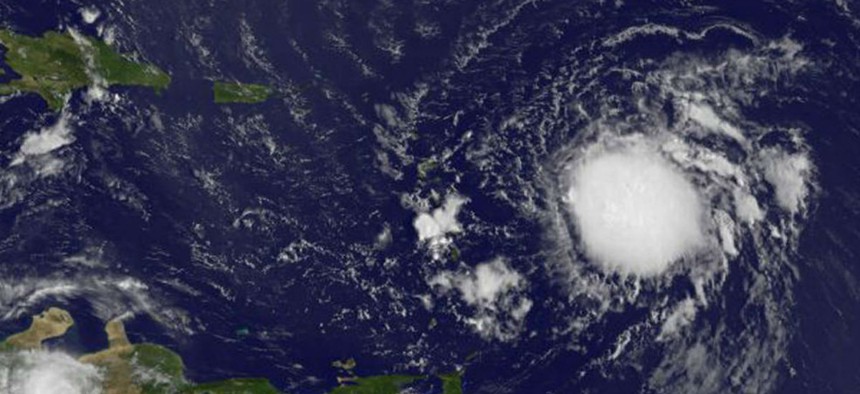NOAA and NASA Plan to Send a Drone Right Into Tropical Storm Erika

This visible image of Tropical Storm Erika was taken from NOAA's GOES-East satellite on Aug. 26 at 7:45 a.m. EDT as it headed toward the Lesser Antilles. NASA/NOAA
NOAA wants to use unmanned aircraft to observe the skies and advance the country's weather forecasting abilities, said NOAA lead systems engineer John Coffey.
The National Oceanic and Atmospheric Administration has teamed up with NASA to harness the observational power of drones to improve weather forecasts.
On Aug. 26, the two agencies expect to launch NASA’s unmanned aircraft Global Hawk from the Wallops Flight Facility in Virginia and aim it straight into Tropical Storm Erika, said NOAA lead systems engineer, John Coffey, in an interview with Nextgov.
The craft will collect a continuous stream of data as it flies either above or in front of the storm.
This is the preliminary phase of NOAA’s four-year mission, called "Sensing Hazards with Operational Unmanned Technology," or SHOUT, which launched in 2014. As the aircraft soars over oceanic regions, it is expected to collect real-time data on moisture, wind speed and wind direction, which scientists will then feed into forecast models at the National Hurricane Center.
The observational data could lead to a drastic improvement in predicting such weather events as tropical storms, winter storms and major floods, according to a NASA press release.
Global Hawk joins a handful of manned planes already in the air collecting data, Coffey said. The difference is an unmanned aircraft can fly at higher altitudes and stay out for longer periods of time.
The plan is for Global Hawk to become a fully functional tool for weather forecast observation, according to NASA.
“It provides us with an observing tool that has the endurance of a satellite but provides finer resolution data and precision of an aircraft," Gary Wick, NOAA’s lead scientist for the mission, said in an agency release.
The project idea was born out of a 2005 paper written by NOAA’s chief science adviser, Alexander MacDonald, Coffey said.
“Since then, we've been fleshing that out, testing a number of different [unmanned aircraft systems] and a number of different domains to accomplish NOAA's missions,” he said.
The tests over the Atlantic Ocean basin are slated to continue until the end of September.





